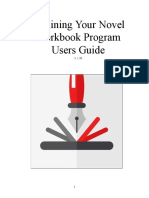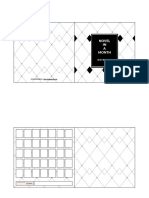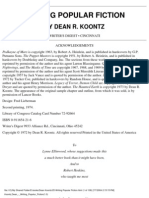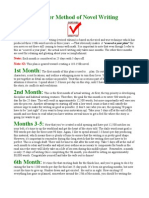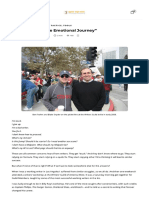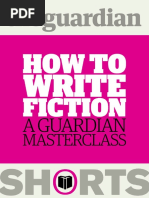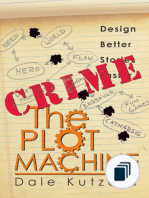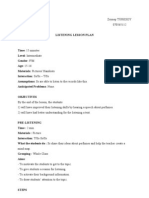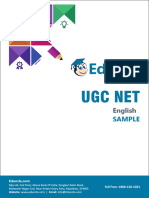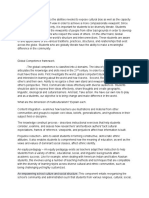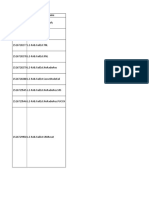Good Story Company Submission Cheat Sheet
Good Story Company Submission Cheat Sheet
Uploaded by
RoseCopyright:
Available Formats
Good Story Company Submission Cheat Sheet
Good Story Company Submission Cheat Sheet
Uploaded by
RoseOriginal Title
Copyright
Available Formats
Share this document
Did you find this document useful?
Is this content inappropriate?
Copyright:
Available Formats
Good Story Company Submission Cheat Sheet
Good Story Company Submission Cheat Sheet
Uploaded by
RoseCopyright:
Available Formats
Manuscript 1. What is your primary goal for this project?
Submission
(Try to be more specific than “get
published”)
Cheat Sheet
2. Who is the audience you’re envisioning for
this project? (Try to be more specific than
“everyone”)
3. Is your project more “mass market”
CHECKLIST
(imagine a pulp paperback) or an artisanal
project (imagine a literary chapbook or
This cheat sheet contains all of the information
beautiful coffee table object)?
you’ll need to gear up for submission, do
4. How much help and guidance do you want
amazing research, and pitch your project in
from a potential agent or publisher? Do
the strongest way possible.
you want to communicate often or are you
more hands-off?
❏ Get Clarity on Your Goals
5. How much control and input do you want
❏ Decide on the Publisher vs. Agent Approach
during the publication process?
❏ Do Your Submission Research
6. What size of agency or publisher feels
❏ Get Your Assets in Order
“right” to you? (Imagine a large
❏ Work on Your Logline and Hook
corporation with many clients vs. a cozy
❏ Write Your Query
boutique with smaller lists)
❏ Write Your Synopsis
7. What kind of relationship do you envision
❏ Write Your Proposal (if relevant)
with your agent or publisher? (Imagine a
❏ Submit!
lifelong partnership or a quick, sales-
❏ Analyze
based transaction)
❏ Regroup and Decide Next Steps
8. What kind of list do you envision yourself
on? Do you care about other writers or
GOALS QUESTIONNAIRE names at that agency or house?
9. How many projects do you have in you as a
Take a look at the questionnaire on the right to writer?
get clarity on your writing and publishing 10. How important is money? How important
goals. are subrights (movie, merchandising, etc.)?
Submission Cheat Sheet | Good Story Company
Page 1
Agent and Publisher
Considerations
SHOULD YOU WORK WITH AN AGENT OR
DIRECTLY WITH A PUBLISHER?
Choosing to submit to a literary agent seems to be the starting place for a lot of today’s
writers. There are pros and some cons to working with an agent. Choosing to submit
directly to a publisher is the choice some other writers make. There are pros and some
cons to working with a publisher without a middleman. Use this checklist to decide which
approach is right for you!
Agent Pros
Agents are your way into publishers closed to unsolicited submission, like the bigger
players (HarperCollins, Penguin Random House, etc.). There aren’t many loopholes
to get you seen there otherwise.
Agented submissions go to the top of the pile. Even houses that accept unagented
submissions will receive projects from agents—and read them first.
Contract negotiations are off your plate. You’ll have an expert in your corner,
fighting for your interests.
The agency will have precedent-filled boilerplates with each publisher, and use the
clout of their big clients to work for you when it comes to clauses, royalty figures,
etc.
Agents act as buffers between you and your house if problems arise.
Most agents will help you revise projects and advise you on career questions and
your overall trajectory.
Agents are connected to foreign publishers and movie agents, so their connections
will help your project get more opportunities worldwide and in film.
Agent Cons
Agents charge for their services, 15% is standard for domestic sales, and 20-25% is
standard for subrights and foreign sales. They take a commission from each royalty
check, too.
Submission Cheat Sheet | Good Story Company
Page 2
Agent and Publisher
Considerations, cont.
If you part ways with your agent, they are still the “agent of record” on the projects
they’ve sold, and will continue to receive commission.
Agents are easily excited by exciting projects, but if you’ve had some obstacles to
success, depending on the agent, their enthusiasm might wane. Not all relationships
will last forever.
Some writers get lost in the shuffle on a big agent’s list, with a big agency, or if their
agent is dealing with a huge client. Self-advocacy can still be required, even if you’re
a client.
Publisher Pros
In approaching a publisher directly, you cut out the middleman and can have more
control over the process of submission. This means the onus of research is on your
shoulders, but if you thrive in that environment, you won’t have an agent telling you
what to do and how to pitch your project.
You can potentially cultivate a strong relationship with a publisher and editor,
without a third party. Some wonderful partnerships have resulted.
You can feel freer to bring your ideas to a publisher without worrying about an
agent’s feedback or submission timeframe. Agents often juggle other clients and so
they are not always responsive.
All the money that’s coming to you is yours alone. You don’t pay a commission to
anyone when you sell directly to a publisher.
Publisher Cons
Many publishers that are considered larger (like the Big Five) will simply not accept
unagented submissions (those pitched without a literary agent).
As a result of the above, you will likely be working with smaller or regional
publishers. If you have a “niche” project that might do really well at a more modest
house, though, this is not a big deal.
Submission Cheat Sheet | Good Story Company
Page 3
Agent and Publisher
Considerations, cont.
It’s up to you to negotiate your contract. Do note that the publisher will be fighting
for their bottom line the entire time. Many writers report fearing that the offer will be
withdrawn at every turn, which might make you more likely to accept their terms.
The monetary terms and the advance, if any, tend to be more modest for writers
who approach a house independently. Not just because you’re working with a
smaller publisher, but because you have little leverage compared to an agent who
may represent other longstanding publisher clients.
If you hire an intellectual property lawyer to look over your contract or settle any
disputes with the publisher, this comes at an up-front cost to you.
If problems arise with the publisher, you will have to navigate these waters with
diplomacy. Relationship maintenance will be entirely your responsibility.
Submission Cheat Sheet | Good Story Company
Page 4
Submission Plan
THESE ARE YOUR NEXT STEPS
1. Write the best possible manuscript you can. Make sure to get it reviewed by
qualified readers, whether a critique group or freelance editor.
2. Get trusted feedback on the project to help make it as strong as possible.
3. Make sure you have a strong sense of its category, and how you will pitch it. Is it
general fiction? Picture book vs. chapter book? Is it a genre? Which one? Make sure
it fits the categories of that genre or category. Is it the right length? Does it employ
some of the conventions of the category (there are many popular tropes in romance,
for example)?
4. Research your possible venues, from agents to publishers (if you want to submit
directly to houses).
5. Narrow down your options in terms of one agent per agency or one imprint per
publisher. Research the person you’re targeting and try to find some personalization
details to use in your submission. (Some publishers or agencies will direct you to a
general submission box, so personalization is not always possible.)
6. Write and assemble submission materials:
a. Query
b. Synopsis
c. Sample Pages
d. Nonfiction Book Proposal (if applicable)
e. Art Portfolio (if applicable)
7. Do comprehensive agent and/or publisher research.
8. Narrow down your final submission list of 10-15 agents and/or publishers. Review
their submission guidelines.
9. Prepare your query and submission materials in a format that’s ready to send.
10. Send away to each recipient according to their submission guidelines.
11. Meanwhile, work on your next project, develop your portfolio, create your online
presence, read writing reference books, take a class, go to a conference, and
otherwise do professional development!
12. Compile your responses. Decide if you have enough new ideas to do a revision and
resubmit. Perhaps you want to try independently publishing, or moving on to a new
project while you decide what to do with your current work.
Submission Cheat Sheet | Good Story Company
Page 5
Submission Rules and
Considerations
SET YOURSELF UP FOR SUCCESS
As you prepare to submit, here are some ground rules to keep in mind:
1. Ideally, your first round of research will result in 20-30 names that are compelling to
you, whether those are publishers or literary agents.
2. From there, you will dive deeper and segment your targets into an A List of 10-15
names, and a B List of 10-15 names. If you find even more people you’d like to pitch,
but are maybe lukewarm about, you can also add a C List.
3. Remember the golden rule: DO NOT pitch more than one editor/imprint at a
publisher and more than one agent at a literary agency at a time.
4. It is perfectly acceptable (and beneficial to the writer) to send all of your submissions
at once. This is called a “multiple submission” or “simultaneous submission”. Just
make sure to mention that you’re doing so somewhere in your query letter.
5. Do not grant exclusivity unless you have a compelling reason to do so. It does not
earn you any additional favor with an agent or publisher. But if someone asks you to
submit exclusively, you can decline, unless...
6. If you are revising for an agent or publisher based on extensive notes, you should
grant them exclusivity (for a specified period, like two to four weeks).
7. Do not contact an agent or editor with a revised manuscript unless you do it ASAP
after sending. Withdraw your project from consideration and send the new version.
Do not do this more than once, or you will look unprofessional.
8. Notify everyone who has responded favorably to your submission (a partial or full
request) if you receive an offer of representation or an offer from a publisher.
Interest from someone doesn’t need to be broadcast elsewhere. If you get a concrete
offer, however, absolutely let everyone else know, and give them time to respond.
9. Most people will consider a manuscript again after they’ve rejected it, but only if
considerable revision has taken place.
10. Follow all submission guidelines for agents and publishers, with, perhaps, the
exception of the “query only” rule. Sometimes it pays to take a risk and send some
sample pages if your opening is amazing. Otherwise, follow everyone’s rules to the
letter as outlined on their websites or in printed notices.
11. SEND NO ATTACHMENTS EVER, unless they are SPECIFICALLY requested.
Submission Cheat Sheet | Good Story Company
Page 6
Research Resources
TO GET YOU STARTED
Here’s a list of websites that will be helpful to writers on the agent and publisher search.
There are some great websites and blogs here, and all are worth a read, whether you’re
actively searching for agents or publishers in any stage of the game.
MANUSCRIPT WISH LIST: manuscriptwishlist.com
A great and frequently updated resource that collects wish lists from agents and
publishers. Add this to your research and see if you can catch the right gatekeeper at the
right time with your project. Also check out the #mswl hashtag on Twitter!
AAR: aaronline.org
The Association of Authors’ Representatives is a list of member agencies that have joined
and agree to abide by ethics codes and standards. Andrea Brown was one of the co-
founders of the AAR.
LITERARY RAMBLES: literaryrambles.com
Agent Spotlight is a feature of writer Casey McCormick’s ambitious roundup of an
agent’s interviews, web presence, and submission information. It’s a careful analysis of
an agent and their reputation in the marketplace. You can see the agents she has done in
her left-hand sidebar. Worth a read. She must be a researcher or a librarian or
something, because the amount of work that goes into each article seems staggering!
AGENT QUERY: agentquery.com
A searchable database of agents where you can use the Advanced Search function to
narrow down the results to an agent’s specific tastes. Want someone who represents
both fantasy and young adult? Check the boxes and see who fits your criteria. There are
other things you can search for, too. Results give you contact information and recent
sales.
Submission Cheat Sheet | Good Story Company
Page 7
Research Resources, cont.
WRITER'S DIGEST: agent resource blog
Writer’s Digest keeps a blog where they profile agents, introduce new agents to the
writing community, interview writers about their agents and otherwise talk about agents!
You can also check out the Writer’s Market and Children’s Writer’s and Illustrator’s
Market books, updated annually.
QUERY TRACKER: querytracker.com
This is a pretty similar website to Agent Query (above), but it also lets you organize and
track your query and submission status. What people were once doing with
spreadsheets is now online! There’s also, I think, a community element to this where you
can interact with other writers.
PUBLISHERS MARKETPLACE: publishersmarketplace.com
A paid resource ($25/mo) for agent and publisher research. They have lists for picture
book, middle grade, thriller, memoir, etc. I recommend that everyone join it for at least
one month while doing research (you can always cancel at any time). You can see who’s
selling, how much, how often, to which publishers, etc. Agents sound great on paper on
their websites, but I think track record is more telling. Same for publishers. Which ones
are doing deals in your category?
Submission Cheat Sheet | Good Story Company
Page 8
Asset
Here are some ideas for developing your assets as a writer. You
don’t have to do all of these things at the same time, but if you
Checklist
ever find yourself stuck for ideas, consider pursuing one of
these projects. Remember to be professional in all of your
dealings, especially online. If you want to be a writer, act like a
HERE ARE SOME
IDEAS FOR writer, and present yourself as a professional. Be sure to let
DEVELOPING everyone know about published pieces and your successes by
YOURSELF AND updating your social media—but be careful. People who only
YOUR ASSETS talk about themselves and their projects online don’t make it
AS A WRITER
very far. Be useful and helpful by sharing news stories and
articles that your readers might find interesting.
Remember to provide enriching content, so that people see you
as someone of value, not just as an advertising channel for your
own endeavors.
Strong follow-up projects, whether sequel or stand-alone
Especially important for picture book writers
Published clips on blogs, in literary magazines, online
journals, trade magazines
Whether they’re relevant to your project subject or not,
professional writing clips will help establish your
experience as a writer
Be cautious about publishing excerpts from your longer
fiction work, as that could make it unattractive to
publishers
A strong informational website
Compelling static home page with info about you
A more detailed About page
Projects page (avoid posting materials, just pitches)
Published Work page (for your clips, if applicable)
Contact page (with a form or email link)
A blog (if time allows)
Submission Cheat Sheet | Good Story Company
Page 9
Asset
Keep it timely and topical, with updates monthly at the
very minimum
Checklist.
This can be a tab on your informational website, or a
standalone
cont. Social media profiles
Linked In
These only work if you keep them active
Post or repost news stories that have to do with writing
or the topic of your book or story
Feature yourself as your profile, make sure you look
professional
Conferences and writing events
Go to as many events as you can, both regional and in
big media cities (New York, Los Angeles), write about
your experiences on your social media sites
Practice pitching your work at events or online
Local literary events
Get a feel for your local writing community
Network with other writers at events, without being too
pushy about your own work
Message boards and forums
Contribute to threads and build up a following in writing
communities online
Find potential critique partners and discuss writing
topics (check out Crit Collective to look for a
connection!)
Other writers are going to be your biggest readers and
supporters early on
Submission Cheat Sheet | Good Story Company
Page 10
Pitch and Logline
SUMMARIZING YOUR WORK
A pitch and logline are related terms for a quick written or verbal summary of your story,
usually communicated in a “hooky” and enticing way. A pitch can sometimes be longer
than a “logline”. Pitches can go on for several sentences, but loglines generally tend to
be single sentences.
To write a compelling pitch, you need to think about the following:
Who your character is
The biggest challenge they face
The personal stakes of this challenge (what happens if they fail?)
Anything interesting about your setting or premise (usually more relevant for fantasy,
sci-fi and other genre stories)
Pitch
A standard pitch or logline combines all of the above. Here are two examples:
In a world where aliens rule the planet, the last remaining Earthling must use ancient
powers she just discovered to keep the human race alive.
As Ingrid fights for a woman’s right to vote, she falls in love across the picket lines. How
does she stay true to her cause ... and her heart?
We get a sense of the world, the character, the primary conflict. These are the three
ingredients of a strong pitch. You can embellish this basic formula with more information
if you’re pitching in person. You can also use this as a starting point to develop your
query letter paragraphs. Or leave it short for a logline that can be the beginning of a sit-
down pitch or a query letter.
Meets Comparisons
A popular formula for pitches and loglines is the “meets” comparison. If one doesn’t
Submission Cheat Sheet | Good Story Company
Page 11
Pitch and Logline, cont.
come easily to mind, don’t worry. Some projects are naturally suited for this, and there
are some where it doesn’t make sense. This is a nice jumping-off point for a pitch but
shouldn’t replace a longer and more thoughtful articulation of your idea. Be sure to pick
properties that are largely familiar in popular culture:
Imagine the characters from The Fault in Our Stars stranded in a Lord of the Flies
scenario.
My novel is Jane Austen meets Jurassic Park.
(You’d think this would be a ridiculous premise, but the world does have a book called
Pride and Prejudice and Zombies...)
One note about comparative titles and any properties you use to draw attention to your
own: You do not want to earnestly compare yourself to something that's too popular.
Literary agent eyeballs roll at "It's Harry Potter meets Twilight!" These properties are
simply too big, and making this kind of comparison may communicate that you have
unrealistic expectations of your own work and your potential in the market.
You will notice that I use Twilight as an example for my query letter a bit later in this
resource, but that's exactly because everyone in the world knows the story and I don't
have to explain the finer points—the focus can be the query.
Submission Cheat Sheet | Good Story Company
Page 12
Crafting the Query
FORMATTING AND QUERY COMPONENTS
Query formatting confuses a lot of writers but is actually quite simple. Queries have
several moving parts. They are defined here:
Personalization
If you have a personal reason for contacting the agent or publisher, make it specific. For
example, “I’m querying you because you represented my favorite book, Title.” This is
specific and speaks to that agent or publisher’s experience. If you have personal
experience with this person, that’s always relevant here, “I’m querying you because we
met at [Name of Writing Conference] in [Month, Year], and you requested the first ten
pages of my work.” If you have it, use it!
An example of bad personalization would be, “I’m querying you because of your passion
for literature.” This is vague and can be said of anyone working in publishing. Agents and
publishers, of all people, can recognize a form letter. So if this is the best you have to
offer, omit the personalization element. Your best weapon here is strong research to
find connection points with the people you’re querying, if at all possible. The
personalization section is optional.
Comparative Titles
If you find that you have something in common with books or authors already on
shelves, feel free to use comp titles. For more considerations on choosing comps, follow
this link. The comp title section is optional.
Logline
This can use your comps (“It’s Sharknado meets Like Water for Elephants.”) or you can
write a one-or-two sentence pitch at most that summarizes your story. If you are using
personalization and comp titles, you can skip the logline. If you have nothing else for the
opening to your query, you may want to consider a logline. This is just a one-sentence
Submission Cheat Sheet | Good Story Company
Page 13
Crafting the Query,
cont.
summary of your main character, their primary conflict, and the stakes. For example, “In
1990s suburbia, an aspiring teen rock star struggles to break out and find his voice
before he becomes a prep school zombie like his twin brother.” But loglines are also
largely optional, because you are going to be pitching the story in much more detail with
the heart of your query (described in the next section).
Manuscript Logistics
This is where you mention the title, category, word count, and anything else relevant to
your manuscript, like any unusual narrative choices. For example, “Title is a 51,000-
word middle grade fantasy manuscript told in second person direct address,” or “Told in
dual narrative POV, Title is a 75,000-word literary novel in verse.” The title, word count,
and category are the bare minimum here.
The Heart of the Query
Between one and three paragraphs that present the character and plot of your fiction
project, or create a market and need for your specific nonfiction premise. I sometimes
call this the "query meat." For picture books and book proposals, which will follow the
query in their entirety, this meat can be shorter. Picture books will focus on character,
plot, and the universal theme or lesson learned. Book proposal queries (which are more
cover letters than anything) will focus on the market, the unique selling proposition of
the query, and the writer’s marketing reach. For fiction, please see the following section
on writing the query meat for more detail.
Biographical Information
All about you. It’s strange when this section is entirely missing, so think of at least one
sentence to include. On the other hand, don’t go overboard with voice, jokes, or
personality. Don’t make your bio longer than the query meat. Include only professional-
sounding and relevant details. If you have writing credits, publications, or contest wins,
Submission Cheat Sheet | Good Story Company
Page 14
Crafting the Query,
cont.
make sure to cite the publication name, year, and any contest names. Be specific, or
readers will assume that your credits are self-published. If they are, say so. Avoid being
too cheeky, again. The number of cats you have is probably not going to be relevant,
unless you are writing a cat book, for example. Focus on writing experience and life
experience that’s relevant to the book project at hand.
Query Logistics
This is your breezy sign-off to the query itself. It can literally be: “Per your guidelines,
the first XYZ (pages or chapters) are enclosed below. Please note that this is a
simultaneous submission. Thank you very much for your time and consideration.”
Simultaneous submissions (sending to more than one person at a time) are considered
industry standard, but they’re still worth mentioning.
Name and Contact Information
Exactly what it sounds like. Your real name, a pen name, if you’re writing with one, the
best contact info to reach you (ideally email and phone number minimum, but you can
include your mailing address), and then any web credentials like your website URL and
social media profiles. These can all go underneath the letter on separate lines.
These are the basic query elements. You can rearrange them a bit, as you'll see. But for
the most part, this is how they appear in all queries. A few are optional. The more you
can include (and the more correct and relevant it is) the better. But keep in mind that
most queries are going to be 200-400 words. Just because you cover a lot of information
doesn’t mean your query has to be long.
Submission Cheat Sheet | Good Story Company
Page 15
Query Formatting
ORGANIZE YOUR INFORMATION
Three perfectly valid versions of how you might want to organize your query letter:
Example Query 1:
Paragraph 1: Personalization
Paragraph 2: Comps, Logline, Manuscript Logistics
Paragraphs 3-5: Query Meat
Paragraph 6: Bio Info
Paragraph 7: Query Logistics
Name and Contact Info
Example Query 2:
Paragraph 1: Manuscript Logistics
Paragraphs 2-3: Query Meat
Paragraph 4: Bio Info
Paragraph 5: Query Logistics
Name and Contact Info
Example Query 3:
Paragraphs 1-3: Query Meat
Paragraph 4: Personalization and Manuscript Logistics
Paragraph 5: Bio Info
Paragraph 6: Query Logistics
Name and Contact Info
Submission Cheat Sheet | Good Story Company
Page 16
The Heart of the Query
WRITING THE QUERY MEAT
Whether you pitch an agent in person or with a written query, your goal is the same: to
get us to request your manuscript. When you pitch in person or write a query, make sure
to answer these questions about your manuscript:
WHO is your character?
Edward Cullen is your typical teen vampire. Good looks, fast car, no pulse.
WHAT is the strange thing going on in his or her life that throws everything off-kilter
and launches the story?
Then he meets Bella Swan.
WHAT (or who) do they want most in the world?
For the first time, Edward wants a human being more than anything. And he
wants her alive.
WHO (or what) is in the way of them getting what they want (their obstacle)?
Edward’s bloodlust could drive him to either kill her or turn her into a monster
like himself.
WHAT is at stake (no vampire pun intended) if the character doesn’t get what they
want?
If Edward doesn’t get Bella or, worse, if he hurts her, he’ll be alone forever.
Literally.
Answer these questions about your own manuscript. Read the backs of published books
and the jacket flap copy. This is roughly the length and tone you’re going for with a
verbal pitch or the meat of your written query letter. The most well-crafted queries, in
my opinion, are ones that make me care about the story and characters. They make me
feel something. They make me want to know what happens next. For more on this, click
here.
Agents and editors want to hear from writers. They want good projects. They simply
can’t do their jobs without them. So present the juiciest, most compelling points of your
story, mention the important details outlined above, and, finally, have fun and be
yourself!
Submission Cheat Sheet | Good Story Company
Page 17
Crafting a Synopsis
YOUR PLOT AND CHARACTER SUMMARY
Many writers hate creating a synopsis—and for good reason. They tend to be dry,
daunting documents that are full of facts. As writers, we always want to add voice to our
work. This is nearly impossible in a synopsis.
Here’s the dirty synopsis secret: If you hated writing it, they’ll probably hate reading it
just as much.
You’ll notice that some agents don’t even request a synopsis. This is good news. The
pressure is off! Just do your best to convey the flow of your story, and you likely won’t
be evaluated too harshly on this document alone.
Here are some synopsis considerations to keep in mind:
1. The synopsis should be either one or two pages long, double-spaced. I’d suggest
doing an exercise and writing two versions, one short, and one longer.
2. Your synopsis should contain a chronological retelling of your plot. That’s it and
that’s all.
3. If there are big deal character developments, be sure to mention those as they
dovetail with the plot.
4. Yes, you do need to reveal any plot twists or surprise endings. Agents and publishers
will want to see the full scope of your plot.
5. The tone of the synopsis should be very matter-of-fact. This is NOT a document
where you should pitch or tease or withhold information.
6. If you find yourself with an overlong synopsis, think of all the things you could delete
that, if missing, wouldn’t impact the reader’s understanding of the story.
7. Clarity is key, above all else. The synopsis should present information, instead of
raising questions or introducing confusion.
8. Give your synopsis to a friend or critique partner. Then ask your reader to tell you
the gist of your story. If they seem totally confused, it’s time to take a second look at
your document.
Now knock it out, worry a bit less, and you’ll be on your way! You can learn more here.
Submission Cheat Sheet | Good Story Company
Page 18
Crafting a Book Proposal
IF YOU'RE WRITING NONFICTION
If you’re writing a book proposal for a nonfiction project, I highly recommend checking
out How to Write a Book Proposal by Jody Rein and Michael Larsen and The Weekend
Book Proposal by Ryan Van Cleave. It goes into a lot of detail about the exact
components and organizational flow of such a project. For your book proposal, you will
primarily be covering:
WHO are you?
The expertise and experience that makes you the perfect person to write about
this topic in a way that hasn’t been done before.
WHAT is the new message, revelation, or take-away?
If you want to write a fitness book, you need to bring something new to the
marketplace. How are you going to innovate your subject area and give readers
something new?
WHO is your audience?
What are the specific demographics of your target audience? Non-fiction books
thrive on market segmentation, and you need to be able to discuss, at length, the
population that will read your work, and why it will appeal to them.
WHO is your competition?
Prepare to do rigorous market analysis for your idea. Who else is out there, what
have they done, and how is your project different?
WHAT are your marketing opportunities?
How do you plan to reach your audience and what avenues exist to connect you
to your readers? What is your personal network and what are the marketing
assets that you bring to the table?
Be prepared to include two or three sample chapters of your book with the proposal.
These chapters should represent the overall style of the book and if there’s a big chapter
that really focuses on the unique idea or message that you’re writing about, try to
include it. Don’t just write a few introductory chapters—really give agents and publishers
some of your main substance to consider.
Submission Cheat Sheet | Good Story Company
Page 19
Crafting a Book Proposal,
cont.
A note about creative nonfiction: Sure, it’s called “nonfiction”, but creative non-fiction
like memoir (think Wild by Cheryl Strayed) is less frequently sold on proposal. If you are
well-published already or you have a newsworthy public name or story, you can sell on
proposal. If you are an unknown writer trying to sell your life story, treat it as you would
a novel. I would highly recommend doing everything required for a book proposal in
addition to having your manuscript complete. Since narrative non-fiction involves a lot of
storytelling, agents and editors will want to see your narrative craft, and a few sample
chapters may not be compelling enough.
Submission Cheat Sheet | Good Story Company
Page 20
Questions
Agents and editors will be asking you questions too. They want
to know more about you before they make up their minds.
an Agent or
They’re interested in your attitude toward this project, as well
as how you might handle marketing and future projects. This list
Publisher comes from this blog post. Here is a sampling of what to expect:
Might Ask 1. More about you and your background. They want to know
you personally and get a sense of how easy or difficult you
You might be to work with.
2. What are some of your revision ideas for this project?
PREPARE FOR 3. Do you agree with the revision ideas provided? (It’s okay to
YOUR disagree, but then you need to ask yourself whether this
INTERVIEW particular agent or editor is the right fit for you. But don’t be
CALL WITH AN afraid to speak up.)
AGENT OR
4. What is your revision style? How do you see us interacting
PUBLISHER
as you work on the feedback?
5. What are some future ideas you might have?
6. What are your goals for this book? What audience do you
envision for it?
7. What are your overall career goals?
8. What kind of writing assets and online presence do you
have? How do you plan to promote yourself and your work?
Submission Cheat Sheet | Good Story Company
Page 21
Questions
When speaking with an agent or publisher, it’s important to
learn about their working style and their vision for your project,
to Ask an
how they’d work with you to make your dream a reality. This list
comes from this blog post. Here are some questions you can
Agent or ask:
Publisher 1. What is your communication style? Do you prefer phone or
email? Do you check in often even when we’re not on active
submission?
THINGS YOU
MAY WANT TO 2. Tell me more about how your agency or publisher works
KNOW WHEN and handles clients. Is there an agency agreement for new
SPEAKING TO A clients? (There usually will be, it’s okay to ask to see it
POTENTIAL REP
OR PUBLISHER beforehand.) What are steps for termination? (You hope it
doesn’t happen, but you need to know that there's an out.)
3. For agents: What books have you sold and what publishers
do you work with? For publishers: Where does your house
get distribution for books it publishes?
4. For agents: What is your submission strategy? Do you go on
a big round to editors or do you do smaller rounds that let
us hear feedback and make changes, should we need to?
For publishers: What kind of marketing support do you
provide?
5. For agents: How would you position this book to editors?
Where do you see this fitting in with publishers' lists? For
publishers: What is your target audience for this book?
6. What editorial changes do you think I should make to this
manuscript?
7. What happens if we don’t sell this book?
8. How do you work on revisions with clients?
9. How do you work with clients as they’re generating new
ideas?
Submission Cheat Sheet | Good Story Company
Page 22
Decoding Rejection
MAKING SENSE OF ANY DECLINES
It may surprise you to know that there are different levels of rejection. Each type of
rejection means something different. This list is adapted from this blog post:
Form Rejection: You are rejected but don’t receive any feedback or thoughts.
Gatekeepers will sometimes personalize with your name and the name of your
project but don’t say anything specific about it. This is usually what people send
when the writing isn’t solid enough, the voice doesn’t grab them, the idea doesn’t
resonate, etc. You get one of these if your work is obviously not a fit, or obviously
not polished enough, which most readers can tell almost immediately. Watch out,
sometimes rejections that SOUND personal are actually still form verbiage. For
example, “The writing didn’t resonate with me as much as I wanted.” You think
they’re talking about you, but they probably send this same message 30 times a day.
It isn’t malicious, they simply don’t have time to go into detail with every submission.
Personal Rejection: The gatekeeper will still pass on the submission but provide
general feedback. They will use this one either for a query that they thought had
promise or an easily articulated flaw or sometimes for a full manuscript that falls
short of what they were hoping for. Maybe the project shows potential but isn’t right
for their list—which isn’t something the writer can help. Or maybe the agent or
publisher will have thoughts on how it could be improved before they’d consider
representing it — which the writer can take into account if they wish. These
rejections are a bit more specific but don’t give detailed editorial notes, however.
This type rejection is reserved for a project that shows promise but might be still a
little too much work to get into. If you’re getting a lot of these, that means you have
some definite strengths, but there may be big problems with the writing, plot,
character, or overall premise. Sometimes these are the most frustrating rejections
because they aren’t detailed enough to guide you during a revision.
Revise and Resubmit: This is only for cases where the agent or publisher has read the
full manuscript, or maybe a longer partial. In this situation, they’ve spent some time
with the project and will give you specific notes for revision. If you revise, the agent
or editor would love to see it again. They will often ask to consider the project
exclusively.
Submission Cheat Sheet | Good Story Company
Page 23
Checklist for Regrouping
ANALYZING YOUR PATH FORWARD
The dust has settled from your submission round and you have aggregated your
feedback, checked your submission lists, and considered your options. It's important to
note that each writer, each submission, and each manuscript will have its own life.
Be open-minded to the possibilities presented to you each time you go out on
submission or receive feedback. This is always an emotional time, but could present a
valuable moment to pause, evaluate, and reflect.
Here is a checklist to help you decide what to do next.
Do you want to continue with this manuscript?
If YES: See below
If NO: Put it aside and work on something new, some new creative energy could
reinvigorate this project as well—there’s no reason to decide right now whether
or not you’ll ever touch this manuscript again
Do you still want to pursue traditional publication?
If YES: See below
If NO: Consider publishing independently, which is, unfortunately, beyond the
scope of this particular resource
Did you receive a lot of feedback that you can use?
If YES: Consider revising your manuscript, updating your submission list, and
submitting again
If NO: Consider hiring a freelance editor or finding a critique partner for some in-
depth manuscript advice
Have you completed a revision?
If YES: Assemble your revised submission list, query, and samples—be sure to
mention that the agent or publisher has seen the project before if you are
resubmitting
If NO: Don’t rush, you only get one chance to show off a great revision, so take
all the time you need—and then some
Submission Cheat Sheet | Good Story Company
Page 24
Checklist for
Regrouping, cont.
Will you keep going with this manuscript if you encounter another unsuccessful
round?
If YES: Consider getting more feedback on the project, and maybe making big
changes, whether that’s changing categories completely, totally revising the
pitch, adding new character or plot layers, etc. If you plan to revise again, you
may want to step away for several months before you dive in
If NO: Consider some writing education or networking at conferences or events,
work on yourself as a writer (your writing assets) and then cast around for a new
project to focus on
Submission Cheat Sheet | Good Story Company
Page 25
What's Next On Your
Submission Journey?
This Submission Cheat Sheet is not meant to be an exhaustive deep dive into the process
of submission or agent and publisher research. But I hope you've found some ideas to
kick your personal submission journey into high gear.
Well, Now What?
Prepare to Learn a Lot: Submission represents the culmination of a lot of work on
your part. But it's also the potential beginning of another journey. Publishing is a long
road—a marathon, not a sprint. Make sure you have another project in the works so
that you always have next steps to take.
Button Up Your Assets: Before you submit, make sure everything is ready to go,
including an awesome project and strong submission list—backed by your best
research.
Dig Deeper: If you found this to be a tantalizing peek at the submission and research
process, you're welcome to take my Manuscript Submission Blueprint, an eight-hour
video class on these exact topics. You'll have a lot more support in every aspect
covered here.
Marketing Mastery Toolbox: If you've realized that you need to work on your
platform-building and marketing, I welcome you to join me in the Marketing Mastery
Toolbox class. You can enjoy $100 off of your enrollment fee with the promo code
SUBMISSION. Use the link above to learn more and enroll.
Finally, help is always an option. I'm happy to bring my experience as a literary agent to
bear and personally do a Query and Synopsis Edit or get on the phone for a consultation.
Sometimes, truly customized advice will get you further than your DIY efforts, and I'd be
thrilled to work with you.
Submission Cheat Sheet | Good Story Company
Page 26
Come Find Us
ONLINE
GoodStoryCompany.com
MaryKole.com
Kidlit.com
StoryMastermind.com
SOCIAL
Facebook
Twitter
Instagram
EMAIL
support@goodstorycompany.com
Submission Cheat Sheet | Good Story Company
Page 27
You might also like
- Writing Subtext, 2nd Edition SampleDocument42 pagesWriting Subtext, 2nd Edition Samplekenlee1336100% (3)
- Upton ConnorDocument10 pagesUpton Connors22kovakrisNo ratings yet
- Minute Pitch by Pilar AlessandraDocument1 pageMinute Pitch by Pilar AlessandraClassroom 34No ratings yet
- 40 Plot Twist Prompts For Writers - Vol. 2Document50 pages40 Plot Twist Prompts For Writers - Vol. 2pippoNo ratings yet
- Hero Journey - A Stranger Comes To TownDocument11 pagesHero Journey - A Stranger Comes To TownJoshua Hockaday100% (1)
- Fiction RevisingDocument215 pagesFiction RevisingShreefali0% (1)
- Hot Offer Checklist: Alex Cattoni'sDocument5 pagesHot Offer Checklist: Alex Cattoni'sAyoola100% (1)
- Writing The Middle-Grade NovelDocument4 pagesWriting The Middle-Grade NovelsivaddsNo ratings yet
- Outlining Your Novel Workbook Program Users GuideDocument32 pagesOutlining Your Novel Workbook Program Users GuideYoonis CumarNo ratings yet
- Beat Sheet Adapted From Save The Cat by LizWritesDocument1 pageBeat Sheet Adapted From Save The Cat by LizWritesMike LikesbikesNo ratings yet
- Required Curriculum - MBA - Harvard Business SchoolDocument4 pagesRequired Curriculum - MBA - Harvard Business SchoolJerryJoshuaDiazNo ratings yet
- Character QuestionsDocument3 pagesCharacter QuestionsAaron Farmer100% (1)
- A Good Man Is Hard To Find by Flannery O'ConnorDocument10 pagesA Good Man Is Hard To Find by Flannery O'ConnorSinta RahmadhaniNo ratings yet
- Mckee Story PrinciplesDocument8 pagesMckee Story PrinciplesUmutNo ratings yet
- Warning Signs! Your Character May Be Acting Out of CharacterDocument3 pagesWarning Signs! Your Character May Be Acting Out of CharacterKM WeilandNo ratings yet
- Novel in A Month Notebook Eva DeverellDocument21 pagesNovel in A Month Notebook Eva Deverellhannah100% (1)
- 02 Novel+Writing+Bootcamp Outlining+ +Three+Act+StructureDocument3 pages02 Novel+Writing+Bootcamp Outlining+ +Three+Act+StructureDương DươngNo ratings yet
- The Writer Vol.129 N 10 (October 2016)Document58 pagesThe Writer Vol.129 N 10 (October 2016)Robert RuginescuNo ratings yet
- Writer's Digest - The 7 Tools of Dialogue PDFDocument4 pagesWriter's Digest - The 7 Tools of Dialogue PDFNexist Xenda'thsNo ratings yet
- 38 Most Common Fiction Writing Mistakes (And How To Avoid Them)Document43 pages38 Most Common Fiction Writing Mistakes (And How To Avoid Them)1265uNo ratings yet
- The Write Structure WorksheetDocument6 pagesThe Write Structure WorksheetAchlys 44No ratings yet
- Page 1Document164 pagesPage 1Ignacio Bermúdez RothschildNo ratings yet
- Writers Digest January 2017Document76 pagesWriters Digest January 2017kskanusharma1No ratings yet
- Write A Novel in Ten Weeks - ThemeDocument20 pagesWrite A Novel in Ten Weeks - ThemebingoflaxNo ratings yet
- How To Write A Scene PostDocument16 pagesHow To Write A Scene Postlucasgio100% (1)
- 25 Writing Popular FictionDocument108 pages25 Writing Popular FictionKromi Lilag100% (1)
- The Kiser Method of Novel WritingDocument2 pagesThe Kiser Method of Novel WritingKen Kiser100% (1)
- MacGuffin PDFDocument9 pagesMacGuffin PDFigoron72No ratings yet
- The Heartful Art of Revision: An Intuitive Guide to EditingFrom EverandThe Heartful Art of Revision: An Intuitive Guide to EditingNo ratings yet
- The Writer Magazine USA April 2018Document54 pagesThe Writer Magazine USA April 2018Ganesh Raaja Natarajan100% (1)
- Professional Plot Outline WORKSHEETSDocument27 pagesProfessional Plot Outline WORKSHEETSClaudia Silva100% (2)
- Romance Novel PlottingDocument43 pagesRomance Novel PlottingAsya LoloNo ratings yet
- 10 Common Mistakes Writers Make and How To Fix ThemDocument18 pages10 Common Mistakes Writers Make and How To Fix ThemVijaiNo ratings yet
- Billy Ray's "Simple Emotional Journey" - Save The Cat!®Document8 pagesBilly Ray's "Simple Emotional Journey" - Save The Cat!®T c pNo ratings yet
- Step OutlineDocument2 pagesStep OutlineHass AminiNo ratings yet
- 29 Worldview Key Scenes and Conventions PDFDocument2 pages29 Worldview Key Scenes and Conventions PDFGerardo Izquierdo PerezNo ratings yet
- And FREE Help, Too!: Exclusively at 48 HR BooksDocument76 pagesAnd FREE Help, Too!: Exclusively at 48 HR BooksAMINUR RAHMAN50% (2)
- Tips On Short StoryDocument17 pagesTips On Short StorynaveenNo ratings yet
- Andrews Socratic PDFDocument4 pagesAndrews Socratic PDFThurstonNo ratings yet
- Creating A Stunning Character Arc Pt. 1: Can You Structure Character?Document3 pagesCreating A Stunning Character Arc Pt. 1: Can You Structure Character?KM Weiland100% (1)
- Commercial FictionDocument170 pagesCommercial FictionVernon Frazer100% (1)
- 42 Fantasy Writing Prompts & Plot IdeasDocument4 pages42 Fantasy Writing Prompts & Plot IdeasnancyNo ratings yet
- 20 Writing Tips To Improve Your CraftDocument26 pages20 Writing Tips To Improve Your CraftSorrosa Andrea GailNo ratings yet
- The Caring TreeDocument22 pagesThe Caring TreeAnonymous qXklPgGnMVNo ratings yet
- Conflict, Action and Suspense - William NobleDocument170 pagesConflict, Action and Suspense - William Noblefital78206No ratings yet
- Character Arc Worksheet Jerry JenkinsDocument3 pagesCharacter Arc Worksheet Jerry JenkinsNick Laur100% (1)
- Your Hero - ThescriptlabDocument5 pagesYour Hero - ThescriptlabPalabras VanasNo ratings yet
- How To Write Fiction PDFDocument81 pagesHow To Write Fiction PDFgringoviejo99No ratings yet
- Writer Forum - 06.2018Document68 pagesWriter Forum - 06.2018Nguyễn Phương Ngân100% (2)
- Brandon Sanderson Lecture Class NotesDocument5 pagesBrandon Sanderson Lecture Class NotesZacharyNo ratings yet
- Trope Example: "Well, I Lay If I Get Hold of You I'llDocument6 pagesTrope Example: "Well, I Lay If I Get Hold of You I'llLiam ScullyNo ratings yet
- Parts of A PlayDocument24 pagesParts of A PlayCarlos RabagoNo ratings yet
- Screenwriting - Different Genres Module GuideDocument4 pagesScreenwriting - Different Genres Module GuideAlessandro Johnson MoriconiNo ratings yet
- How The Antagonist Affects Character ArcDocument3 pagesHow The Antagonist Affects Character ArcKM WeilandNo ratings yet
- Creating A Flexible Outline For Any StoryDocument4 pagesCreating A Flexible Outline For Any StoryMoon5627No ratings yet
- Character Development: How To Write Strong Characters in YournovelDocument16 pagesCharacter Development: How To Write Strong Characters in YournovelnancyNo ratings yet
- Robert Mckee 10 CommandmentsDocument2 pagesRobert Mckee 10 CommandmentsRacquel100% (1)
- Story Writing: Short Stories Usually Focus On A Single EventDocument10 pagesStory Writing: Short Stories Usually Focus On A Single EventMina SamNo ratings yet
- Seven Point Story Structure WorksheetDocument2 pagesSeven Point Story Structure WorksheetJudit MayoralNo ratings yet
- St. Xavier's School Class 11C Project Work: FILM REVIEW (Any Film On Socio-Political Context)Document2 pagesSt. Xavier's School Class 11C Project Work: FILM REVIEW (Any Film On Socio-Political Context)RoseNo ratings yet
- Text 2 - Eating OutDocument2 pagesText 2 - Eating OutRoseNo ratings yet
- HistoryDocument44 pagesHistoryRoseNo ratings yet
- The Second Letter of Paul To The CorinthiansDocument21 pagesThe Second Letter of Paul To The CorinthiansRoseNo ratings yet
- Marketing: An Introduction 13 TH Edition: February 2019Document6 pagesMarketing: An Introduction 13 TH Edition: February 2019Hisham Tariq100% (2)
- Listening Lesson PlanDocument3 pagesListening Lesson Planzynpturksy100% (1)
- Grade-9 Tle ReportDocument5 pagesGrade-9 Tle ReportKing Zor100% (1)
- How The World Works - Unit Letter 4 - FinalDocument6 pagesHow The World Works - Unit Letter 4 - Finalapi-240369918No ratings yet
- Meeting People: How To Greet People How To Introduce Ourselves Asking For Basic InformationDocument16 pagesMeeting People: How To Greet People How To Introduce Ourselves Asking For Basic InformationFitrianti UlfahNo ratings yet
- 41st Annual Conference of The International Society For Exploring Teaching and LearningDocument6 pages41st Annual Conference of The International Society For Exploring Teaching and LearningSTAR ScholarsNo ratings yet
- To Inform & AlertDocument12 pagesTo Inform & AlertFarhan Ali ShaikhNo ratings yet
- Educ 6326 lm7 Teaching Philosophy Exercise FinalDocument10 pagesEduc 6326 lm7 Teaching Philosophy Exercise Finalapi-316237255No ratings yet
- I5 W5 S3 - Reading PDFDocument22 pagesI5 W5 S3 - Reading PDFelysiumlink palnorNo ratings yet
- What Is Artist StatementDocument2 pagesWhat Is Artist StatementRabia Rehman100% (1)
- Business LetterDocument3 pagesBusiness Letterapi-458233671No ratings yet
- Visible Thinking RoutinesDocument1 pageVisible Thinking Routinesapi-55931686950% (2)
- Speaking Up: Six Korean Students' Oral Participation in Class Discussions in US Graduate SeminarsDocument15 pagesSpeaking Up: Six Korean Students' Oral Participation in Class Discussions in US Graduate SeminarsMohammed BanquslyNo ratings yet
- Sample Theory & Que. - Language Basic Concepts - UGC NET ENG. UNIT-5Document23 pagesSample Theory & Que. - Language Basic Concepts - UGC NET ENG. UNIT-5Emily DilonaNo ratings yet
- Nec Topaz Quick ProgrammingDocument30 pagesNec Topaz Quick Programmingsergiomonturil100% (3)
- This Study Resource WasDocument2 pagesThis Study Resource WasZonia Nill100% (1)
- Presenting Furnito - The Next Generation Odoo Ecommerce Theme For Furniture Industry PDFDocument4 pagesPresenting Furnito - The Next Generation Odoo Ecommerce Theme For Furniture Industry PDFjuanatoNo ratings yet
- Stylistic Classification of The English Language VocabularyDocument21 pagesStylistic Classification of The English Language VocabularyLamy MoeNo ratings yet
- ADempiere Doc ProjectDocument21 pagesADempiere Doc ProjectNorbert BedeNo ratings yet
- TerminarDocument2 pagesTerminarmanuel mora monge.0% (1)
- An Empowering School Culture and Social StructureDocument2 pagesAn Empowering School Culture and Social StructureEdrick AnselmoNo ratings yet
- Bussiness Development Associate (Bda) : About UsDocument4 pagesBussiness Development Associate (Bda) : About UsAkshathaNo ratings yet
- CCNA Guide To Cisco Networking Fundamentals: Network ServicesDocument40 pagesCCNA Guide To Cisco Networking Fundamentals: Network ServicesNaveed Khan AbbuNo ratings yet
- Erab CountersDocument14 pagesErab CountersAriev IkankNo ratings yet
- JAST - Volume 16 - Issue Supplementary Issue - Pages 1529-1541Document13 pagesJAST - Volume 16 - Issue Supplementary Issue - Pages 1529-1541Hesti Kris DarwantiNo ratings yet
- Mod 4 - 9 PDFDocument9 pagesMod 4 - 9 PDFAnonymous FIwVj1mNo ratings yet
- Ogl 343 Group 5Document3 pagesOgl 343 Group 5api-597193616No ratings yet
- Business Letter Parts of The Business Letter English 21Document4 pagesBusiness Letter Parts of The Business Letter English 21Hello123No ratings yet








